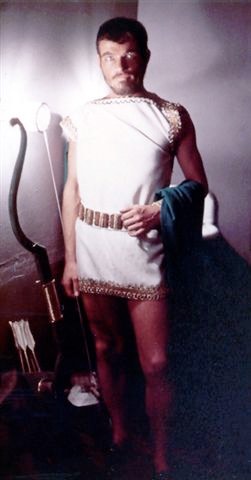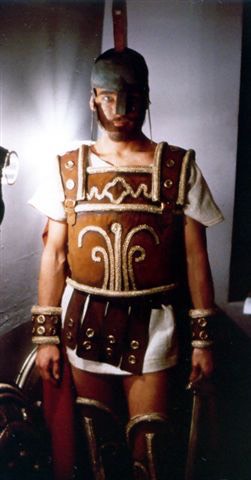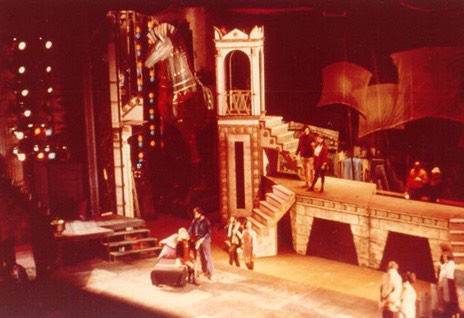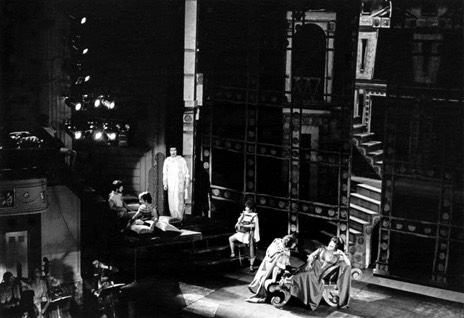
The Trojan Soldier seen here hardly looks like a military man. In fact, in his short white tunic and vivid green cloak (carried, not worn, and barely visible in the photograph, which makes it appear blue), he is actually costumed for the party scene at Didon’s palace. I have an agreement with myself that if I live long enough and other more important matters are completed, I will write at length of the experience of performing under the direction and the baton of Sarah Caldwell in the 1972 first U.S. staging (by her Opera Company of Boston) of the absolutely note-complete score of Berlioz’s masterpiece, and of participating in the musical preparation and language coaching for the production as well. Believe me, the material could be developed virtually to novella length. For now, however, it’s a pipe dream that exists only as a remote possibility.

The Soldier as Warrior
Here our soldier wears the regalia of battle, though it seems clear that it would provide scant protection for life and limb in any dire circumstances, and that the long, blood-red cloak might be quite a liability. The costume designer (Suzanne Mess) was apparently channeling old Steve Reeves movies when she created the “uniforms,” for her tunics (there were numerous changes) never lengthened regardless of the dramatic situation. This meant that when Sarah staged us to sit onstage or actually stand above the audience—the boxes at the front of the theater had stairs and platforms built from the stage up to and on top of them (one of those staircases can be seen in the photo below), to enlarge the playing area of this monumental work and make for some exciting entrances and exits—she would bellow, “Men, keep your legs together!” Énée’s hunky troops were forced into some rather prim physical stances for the sake of propriety.
Rare rehearsal photograph: Opera Company of Boston, Les Troyens, 1972
(Click on image to enlarge)
This is a rehearsal of the entrance of the guests into the great soirée given by Didon to celebrate Énée’s victory over the Numidians, who were invading Carthage (act 4). The sails of the victor’s fleet can be seen at the rear. The wooden horse is for the moment “stored” offstage right (yes, it was triumphantly rolled into the city of Troy at the end of act 1, scene 2; then, under cover of night, the Greek invaders, played by a score or more of young boys who could pass for men because of the perspective provided by distance, did climb down a rope ladder from its belly in full battle dress and disperse through the city). One of the precarious stairways to infinity mentioned in the previous paragraph can be seen at the far left of the photograph. In fact, all the stairs in this production were dizzyingly steep and had the narrowest of treads. On the elevated platform downstage are Leslie Holmes (seated on the divan) and Peter Bugel, the two of them silent stand-ins at this rehearsal for the stars, Régine Crespin (Didon) and Ronald Dowd (Énée). Seen coming up the stairs directly behind them are BB (long white scarf around neck) and the late, wonderful Marguerite Coughlin. The scarf was no silly imitation of Pavarotti (who wasn’t yet known for that shtick at the time, anyway), but a necessity. The production occurred in the dead of winter, and Sarah had no budget for heating the theater during rehearsals. We all froze in there on a daily basis, and that heavy, knitted scarf was regularly wound around its owner’s precious throat! (The photograph is from a slide made by Neal Frederiksen.)
On a later date, and a little farther
into the same act, the wooden horse is safely hidden away (only what’s
appropriate to the scene being rehearsed is now on the stage) and we’re
at the point of working in costume. From the left: BB, Coughlin, Grayson
Hirst (singing Iopas’ aria), Cheryl Bibbs, Dowd, and Crespin (who
insisted the divan be turned the way it is here). The men in short
tunics (BB, Dowd) were instructed to have “legs upstage unless
standing.” This moment is not long before the magnificent septet with
chorus, “Tout n’est que paix et charme.”

